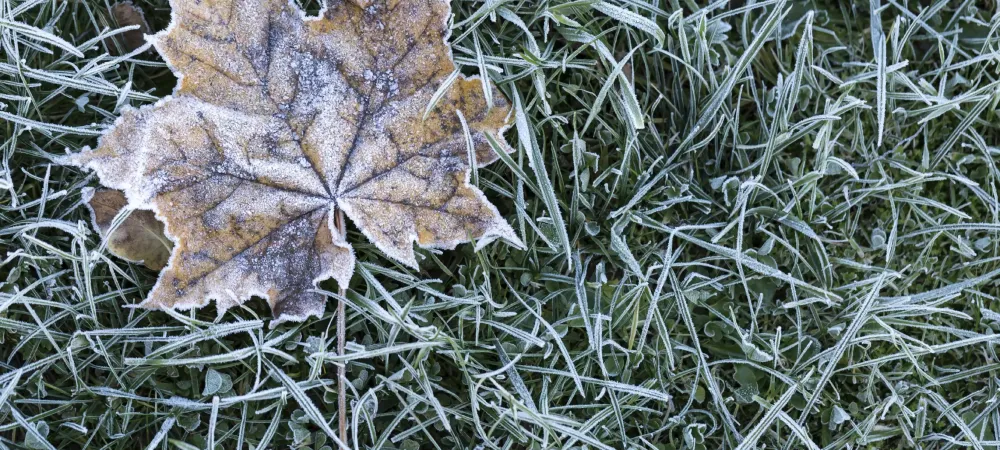Lawn Fungus Identification: Winter Grass Diseases

Ohio winters can be picturesque. The snowfall looks like a lovely postcard. Unfortunately, that same snow can trap excess moisture that causes fungus and lawn diseases. Winter can be tough on lawns, as a number of diseases can take hold when conditions are wet and cold. Here are a few common winter lawn diseases to look out for:
- Snow Mold
- Red Thread
- Dollar Spot
- Pythium Blight:
- Fairy Rings:
- Brown Patch
- Large Patch
Snow Mold
This fungal disease can cause circular patches of discolored, matted grass. It thrives in moist, shaded areas and can be prevented by removing fallen leaves and debris from the lawn, and by avoiding over-fertilizing in the fall.
Red Thread
This fungal disease causes red or pink patches of thin, thread-like growth on the lawn. It is most common in lawns that are low in nitrogen, and can be prevented by fertilizing in the fall and spring.
Dollar Spot
While this lawn disease can strike any time of the year, cool, wet winters are when Dollar Spot can be most prevalent. This disease takes its name because the sunken circles of straw-colored grass it produces are approximately the size of a silver dollar coin. However, this fungus will expand and grow if left untreated until all the smaller spots merge, forming large, ugly patches of diseased grass.
Pythium Blight
This disease can cause large, irregular patches of dead or dying grass, often accompanied by a white cottony growth. It thrives in warm, wet conditions and can be prevented by avoiding over-watering and by keeping the lawn well-drained.
Fairy Rings
Common symptoms of Fairy Rings in your lawn include large circles of dark green or dying grass. Around those rings are another layer. You may find a ring of mushrooms in one of the circles, so this problem is called Fairy Rings. Unfortunately, like fairies, this disease is tricky to get rid of. The affected area becomes water repellant or “hydrophobic,” which means watering the dead grass will not affect. If untreated, Fairy Rings will return stronger each season. Aeration is the key, like with many other fungal infections, because it allows water to penetrate this hydrophobic layer and get to the grass’s roots.
Brown Patch
As you might have surmised, Brown Patch creates large, brown patches of grass in lawns. Unlike other types of lawn diseases, Brown Patch affects all kinds of grass types. It appears as irregular-shaped brown patches of thinning grass. Over time, your lawn becomes thinner and weaker. The immune system suffers, causing your lawn to be more open to attacks from pests, weeds, and other diseases. As temperatures warm up and the weather stays consistently wet, the likelihood of developing brown patch increases. Early detection and quick action can help resolve the issue.
Large Patch
Similar to brown patch, Large Patch is a quick-spreading lawn disease that can cause significant problems to your lawn. The difference between Brown Patch and Large Patch, besides the size of the patch, is that large patch only affects warm-season grasses. (So only our Florida customers have to watch out for this one!) Zoysiagrass, St. Augustine grass, and centipedegrass are all under threat from Large Patch. Appearing as large swathes of thinning, brown grass, a Large Patch can get huge. Typically, a Large Patch can have a diameter around 3 feet but can get as large as 25 feet! In the spring, a Large Patch can be a real menace to warm-season lawns. Watch out for the telltale signs when nighttime temperatures are over 55 degrees. Be especially vigilant after extended periods of wet weather and heavy dew.
How to Prevent Lawn Fungus
In addition to the prevention methods mentioned above, there are a few other things you can do to limit the occurrence of winter lawn diseases:
Aerate your lawn:
Aeration can help to improve drainage and increase the penetration of oxygen, water, and fertilizer into the soil. This can help to reduce the risk of disease and promote healthy growth.
Mow your lawn regularly:
Regular mowing can help to remove diseased grass and promote healthy growth. Make sure to keep your mower blades sharp and mow at the recommended height for your type of grass.
Water your lawn properly:
Over-watering can create a breeding ground for diseases, while under-watering can make your lawn more susceptible to disease. Water your lawn deeply and infrequently to promote deep root growth and reduce disease risk.
Keep an eye on the weather:
Be aware of the weather forecast, and take action to protect your lawn if a period of prolonged cold, wet weather is expected.
Use disease-resistant grass seed:
Some grass seed varieties are more resistant to disease than others. Consider using a disease-resistant variety when reseeding your lawn.
By implementing these measures, you can help to reduce the risk of winter lawn diseases and keep your lawn looking healthy and green all year round. Remember, if you suspect that your lawn has a winter disease, it is best to contact a lawn care professional for an accurate diagnosis and treatment recommendations.
Professional Lawn Care For Lawn Winter Diseases
If you suspect that your yard has a winter disease, it is best to contact a lawn care professional for an accurate diagnosis and treatment recommendations. Land-Art has been helping individuals renovate their lawns for over 45 years, so you know you’ll be in good hands with the technicians who will provide a custom treatment plan for your yard. Don’t let your valuable asset suffer any longer. In the meantime, try to avoid walking on the affected areas, and rake or mow the grass to increase air circulation and sunlight exposure.
